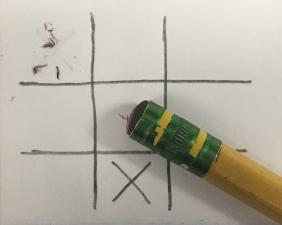One of the great parts of a liberal arts education is finding connections in unexpected places. Throughout my academic life at UChicago, concepts have frequently re-emerged in various contexts, from my classes for the Core curriculum to those for my sociology major or media arts and design minor. Here are some ways that my classes have collided, giving me varied perspectives on similar ideas.
Text & Performance: Staging Terror + Self, Culture, and Society
For the Arts Core, I took a theater class called Text & Performance: Staging Terror. Early on, my professor suggested a way of analyzing our stagings based not on whether they were good or bad, but rather on their effects. Say, for instance, that I forgot my lines and nervously stared at the audience for three minutes before resuming. You could interpret that as me messing up and stop your analysis there. But it might be more interesting to consider what the stare achieved: Did it create intimacy with the audience? Act as comedic relief? Build suspense?
This idea resonated during my Social Sciences Core course, Self, Culture, and Society. In the third quarter of the sequence, we explored the topic of knowledge construction, thinking about why we know what we know. Like the example of my off-script stare, we could just think of scientific and historical knowledge as right or wrong. But it’s often more valuable to consider its effects. Foucault’s The History of Sexuality, for instance, critiques a history of sexuality he terms the “repressive hypothesis,” but rather than simply dismissing it as false, he looks at how that construction of history is deployed in relations of power.

Reading Cultures + Social Structure and Change
Why is a porcelain urinal considered one of the most influential pieces of art of the 20th century? And why is it important enough to come up separately in two of my classes? Well, I first discussed Duchamp’s famous Fountain (which, yes, is literally a urinal) in my Humanities Core course Reading Cultures, in which we discussed its influence through the lens of collection. The urinal gains meaning from its place within an art collection, but it simultaneously uses that meaning to expose the absurdity of the collection, challenging the very concept of art.
In Social Structure and Change, which I took for my sociology major, we talked about Fountain again, this time analyzing how its power as a work of art was socially generated. We used Bourdieu’s field theory to examine the work’s role within the field of art, considering how the artist, art critics, art dealers, and audiences all played a role in giving the piece its meaning. In this way, rather than being Duchamp’s alone, we came to understand the art as a collective collaboration.
The Biological Nature of Psychological Problems + Sociology of Medicine
This is like the Captain America: Civil War of my class crossovers, because there’s some conflict here! I’m currently taking my Biological Sciences Core course, The Biological Nature of Psychological Problems, which looks at how abnormal psychology presents in the brain. It focuses on psychological problems at an individual level, examining individual differences in emotion or cognition.
In Sociology of Medicine, on the other hand, we focus on the role social factors play in categorizing psychological problems or mental illnesses, understanding these topics at a social rather than individual level. In doing so, we look at how issues of race and gender contribute to diagnoses, and how categories of disease affect one’s identity and relationship to society. These biological and sociological approaches are not entirely contradictory, but they provide very different frameworks for thinking through these topics, and it’s been interesting to see how similar phenomena are explained or explored in different ways.
Honors Calculus + Self, Culture, and Society
I know this one might seem like a stretch, but hear me out. We started Honors Calc, which I took for the Mathematical Sciences Core when I was considering becoming a math major my first year, by establishing the basic properties of numbers. In doing so, we defined 0 as the number such that for any number a, a+0=0+a=a. This seems like an obvious mathematical fact, but I thought there was something interesting in that way of defining 0 not through what it is, but through what it does, or how it acts.
In Self, we often thought about concepts in a similar way, not as essential categories but as categories with some function in society. Gender, for instance, could be viewed not as an innate or essential identity, but instead as a concept defined by how it functions, be it as a performance, a tool of power, a facet of interpersonal interaction, or so on. This provides a way of looking at concepts that’s largely relational. 0 doesn’t exist in isolation; it exists in relation to every other number.

Alternate Reality Games + Sociology of Deviant Behavior
In Alternate Reality Games, part of my media arts and design minor, we analyzed the interactions between games and their players. We considered how games and constraints create frameworks for behavior, and, by experimenting with game creation and playtesting, noticed the sometimes surprising ways that players adapt to those frameworks.
This discussion was interesting to me as a sociology major given the frequent language of games and gameplay in sociological theory. In Sociology of Deviant Behavior, for example, we discussed Erving Goffman’s breaching experiments, in which he subtly violated the rules of everyday life. In one experiment, Goffman had his students invite unknowing subjects to play games of tic-tac-toe. After a subject placed their first mark, the student would erase it, rewrite it elsewhere, and then take their turn, giving no indication that this was unusual behavior. The subjects typically reacted with confusion, anger, and frequently some rationalization of the behavior. For instance, they may have thought that the student was flirting with or insulting them. In this way, Goffman showed the fragility of social norms, highlighting the frameworks we adapt to for everyday life.
Throughout college, I’ve been grateful for the opportunity to explore concepts from a variety of frameworks. From my classes for the Core curriculum to those for my concentrations, I’ve been able to gain more depth by exploring ideas from multiple perspectives.